Accommodation Raahe

A house full of stories –
Langi Trading House, a historic hotel in Raahe, brings history to life
A unique hotel in Raahe, offering a unique accommodation experience, in the middle of the historic Pekkatori Square. Langi hotel rooms tell fascinating stories about people from the 19th century – each room is decorated according to a person who influenced Langi’s life. The starting point for the interior design is the person’s life story and its significant moment. For example, the Sea Captain’s Cabin depicts the time when Captain Janne Byström spent his retirement days in Raahe at the end of the sailing era. In the chamber of the Maiden Sofia, we relive the night when Sofia spent her last maiden night before her marriage. Each room has its own story, which you can hear on site using an augmented reality application. Langi Trading House is a unique hotel in Raahe that does not only offer high-quality accommodation – it offers a journey into the past, to the time of the Finnish bourgeoisie and seafaring.
The room price includes a traditional Finnish breakfast, enjoyed in Fredrik's Hall. Offerings include, for example, slow-cooked porridge, homemade rolls with fillings, and Pehr Brahe's pancake with jam.
Pets are also welcome to stay in Lady Johanna's room.
Historic charm and modern comfort
The hotel rooms at Langi Trading House offer a unique combination of the atmosphere of the past and the comforts of today. Each room has its own toilet and shower, and the rooms are individually decorated with antique furniture and details that exude the spirit of the era. However, the centerpiece is a modern, high-quality bed that invites you to a peaceful sleep amidst the stories of old Raahe.
The hotel rooms are located in the culturally and historically significant buildings of the Langin Manor. The buildings were restored during 2016–2022 with great respect for the original architecture and details. Each room tells its own story, but what they all have in common is a warm, cozy atmosphere and a carefully preserved history.

Book a unique place to stay in the heart of old Raahe

Common House
Antiques and unique experiences. A room with a touch of history in the style of a boutique hotel.
The merchant once worked in the corner room of the main building of Lang. In the front room, distant guests were greeted by the accountant, who led the peasants and merchants further into the merchant's office to conduct business. On the other hand, another of the lively hearts of the house must have been the village hall, where the servants lived. The village hall was located in a courtyard building that bordered the courtyard, which has now been demolished.
The new Common House combines the dignified atmosphere of the commercial room with the rusticity of the Common House in a unique way. During the renovation work, a splash of paint was found in the corner of the commercial room, which was well suited to covering the walls of the Common House. The Common House has two parts, and the original ceiling painting of the small hall extends to the back part to decorate the ceiling.
While resting on the double bed in the hotel room, you can stare at the ceiling painting and think about what life was like in this large corner house on the edge of Isontori 200 years ago. The youngest members of the family can spend the night in a unique antique fold-out bed if they wish. The doors can be left ajar if they feel like it… The sofa in the Common House can be made into a comfortable double bed for two adults. In the Common House, time stands still and you forget about the hustle and bustle!


Miss Sofia’s Chamber
Romantic Young Lady’s Room with a Four-poster Bed. High-quality accommodation for special moments in life.
Sofia was born in a merchant family in 1816 and stayed unmarried till the age of 26 – not that she didn’t have any suitors, quite the opposite. Sofia’s problem was the inheritance left by her mother, over 3,000 silver rubles. During those times, it was the husband who always made decisions on his wife’s wealth, so as long as Sofia remained unmarried, she could decide what to do with her money.
Sofia was an exceptional bourgeois girl. She was worried about the dangers poor girls in Raahe were under. What would happen to the uneducated girls? What does it mean for the whole society and its future if women don’t have an education?
She lost her mother at the age of 10. On her mother’s grave, Sofia promised to found a school for the poor girls in Raahe. Her inheritance would be changed into a trust, and the interest would be used to found the school and pay for the teachers. Sofia planned to be a teacher in the school herself too. The determined daughter developed this idea and decided to remain unmarried till she would meet a suitor who would accept her school plan.
In a certain party, Sofia met baron Georg Henrik Lybecker and fell irreversibly in love with him at first sight. The only thing that was dampening this happiness what the fear if she could ever say “no” to this handsome and elegant baron if he was against the school project. To Sofia’s luck, the bridegroom was happy to accept Sofia’s plan and thus, they signed the founding documents of the Lybecker school on their wedding day on the 14th of February 1843. The school is still running in Raahe.
The romantic Miss Sofia’s Chamber is decorated in the style from the time when Sofia slept in it her last maiden night and got married to her great love in the church next door on the following day.

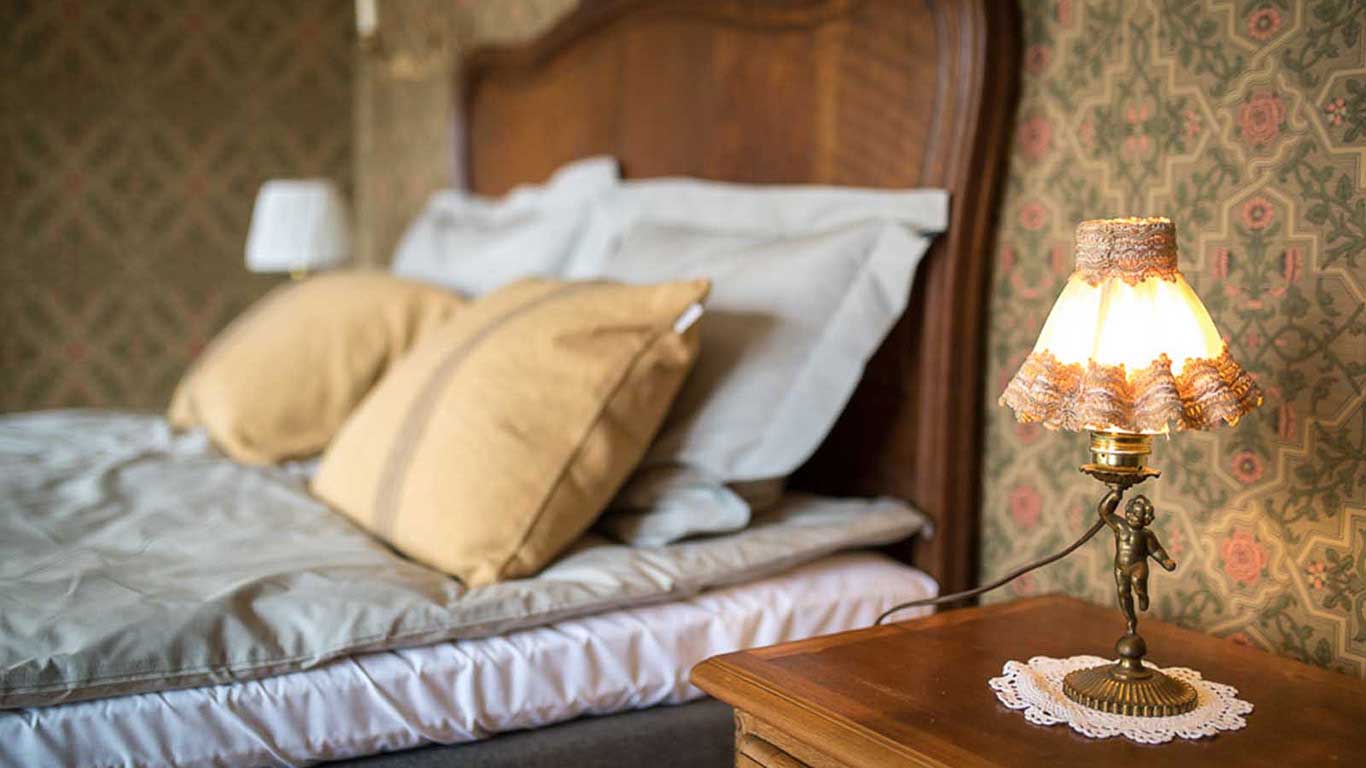
Patron’s Chamber
High-quality accommodation for special moments in life.
Johan Lang received his merchant rights in 1771. When Johan’s house burnt down in the fire of Raahe in 1810, he claimed two plots in the new town plan near the Big Market Square, which was a real cornering. In 1811, he had Lang’s Lower Manor House built on the north-west corner of the Big Market Square and the Lang main building in 1812.
The trade name of Johan Lang is one of the oldest in Finland, still trading in the same location on the Big Market Square corner where his father used trade. At its largest, Johan Lang’s fleet included 11 ships. These ships may have already covered their building costs in the first year they sailed.
Johan Lang was a wholesaler, like many shipowner-merchants were at those times. He brought many articles ranging from ship-building materials to food items and all kinds of trinkets to Raahe from abroad. Smaller merchants and shop owners, in turn, used to buy their goods from Lang’s.
Johan Lang was one of the front-line merchants in his time in Raahe and in the whole of Finland. In the year 1800’s income taxation, he was among the 4 wealthiest merchants in Finland.
Johan Lang was hard-working and frugal. He asked a lot of himself and of his subordinates. In his home life, he had a modest behaviour and a plain, old-fashioned looks. People in Raahe had a lot of respect for him. This respect was shown in many positions of responsibility he had locally and all the way to being a member of the parliament.
Through the windows of the Patron’s Chamber, Johan has been able to follow the life on the square. At his desk, he could have written letters, with a quill and ink by candlelight, to sea captains and other merchants. The patron started his days early with meeting other merchants and captains at the Big Market Square, which nowadays called the Pekka Square. At the square, you exchanged greetings and listened to news from the world and shook hands on building a new ship!

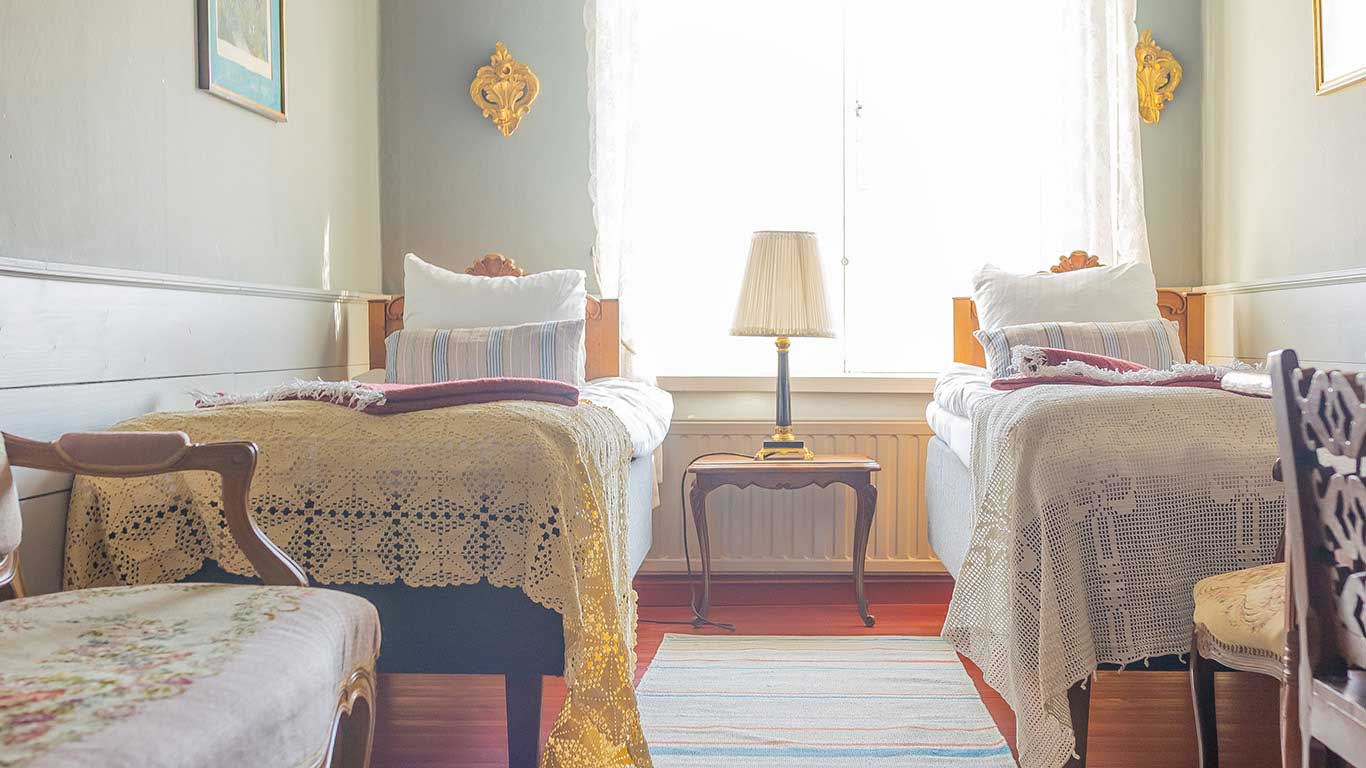
Madam Johanna’s Room
High-quality accommodation for special moments in life. Experience the historical boutique hotel!
Johanna Gustava Franzén née Lang (1796-1826) was the daughter of Johan Lang, who built the house, and Sofia Vidbäck. In 1814, Johanna got married to Zachris Franzén (1787-1852) who worked as an accountant at her father’s trade house. Johan Lang and Sofia Vidbäck (1760-1834) had only daughters. During those times, one’s wealth was inherited from the father, not from the mother, and the inherited wealth was always taken care of by a man, whether that was one’s father, husband or son. The owner family of the Lang Trade House changed thus twice when the company was transferred through marriage first to the Franzén family (1823) and afterwards to the Sovelius family (1859).
Johanna and Johan had three daughters, Helena, Sofia, and Charlotta, and the son Johan. Johanna died in 1826. In 1829, Zachris got remarried to Lovisa Eleonora Frosterus. The couple had three daughters: Johanna (Jenny), Betty, and Nanny and two sons, who both died when they were young. Johanna’s room’s décor is based around the painting in the ceiling. The painting has originally been on the ceiling of a so-called small hall, but as the arrangement of the rooms had been changed already on the 19th century, the painting was hiding underneath a lowered ceiling. The painting’s motifs were used to create decorations on the top parts of the walls, and the room colours have been chosen to match the painting’s colouring as well. The lower parts of the wall are decorated in the Swedish New Classical style with a simple horizontal panel, which is painted grey according to the style. Johanna’s estate inventory was used in the planning of the interior decoration as it included her possessions from ships to darning needles. Johanna was the daughter of a wealthy merchant family and later on a married woman, but from her father Johan, she probably inherited the humble and straightforward personality, which is also reflected in the décor of this room.

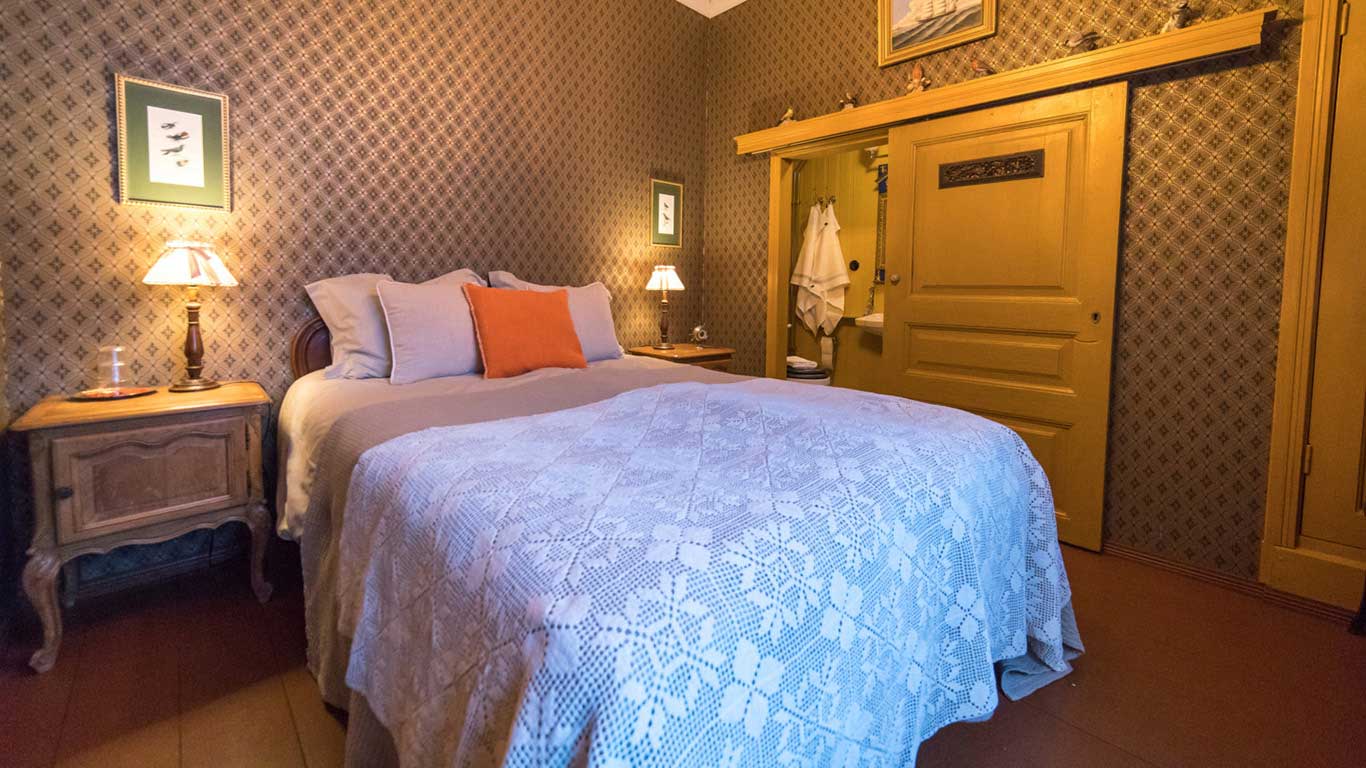
Sea Captain’s Cabin
High-quality accommodation for special moments in life.
High-quality accommodation for special moments in life.
Janne Byström lived at sea for 38 years – for more than half of his life. He worked as a seaman for 15, a mate for 6 and a sea captain for 17 years.
Janne was interested in birds, and it is not an exaggeration to that he was both a sea captain and an ornithologist in one. The captain had bought bird cages and even some birds during his trips, but his favourite hobby was to catch birds that had flown onto the ship and add them to his “collection”. In his cabin, he had ceilings full of birds in cages: canaries, goldfinches, and other singing birds. He didn’t have a parrot, even though many had brought one home.
Seamen had a deep respect for Janne Byström both as a captain and as a human being. This was seen in the way that his ships were always very popular amongst the new recruits. He was seen as a good, reliable and careful sailor. Ship building and seafaring as an industry went down in Raahe at the end of the 1890s, and the biggest factor was the so-called composite ships’ new era, and the merchants in Raahe didn’t want to start investing in the new technology. So, the 57-year-old sea captain became unemployed in the spring of 1895.
The Sea Captain’s Cabin is decorated as it was back in 1896 when Janne was already ashore and had left his stunning career as a sea captain behind him, with the captain’s portrait on the wall and many beautiful birds in the room as memories of his seafaring times. In this “cabin”, Janne spent his retirement years, looking back to the birds flying free in the sky and the stormy nights at sea.

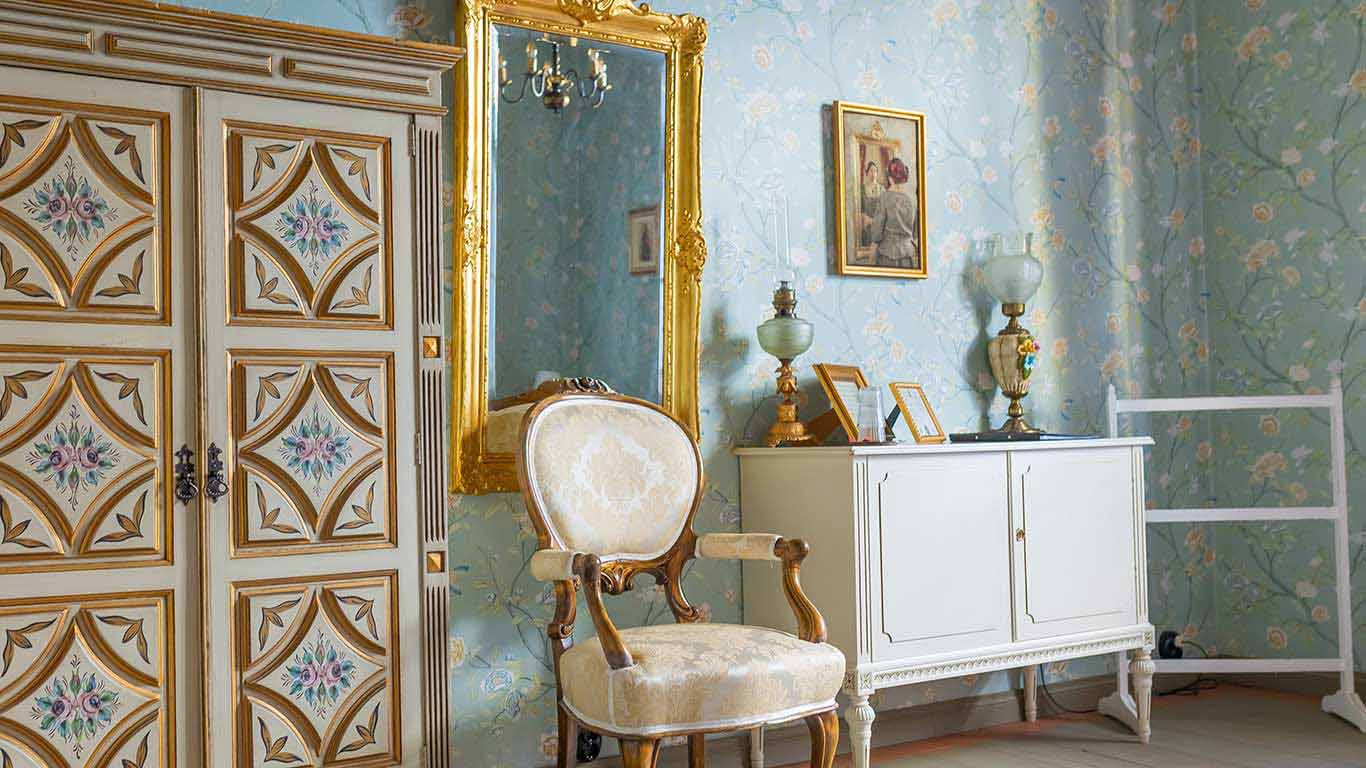
Madam Jenny’s Room
Romantic room for special moments in life.
Romantic room for special moments in life.
Johanna Margareta (1830-1857), who was known as Jenny, was the daughter of Zachris Franzén and his second wife Lovisa Eleonora Frosterus. In 1850, Jenny married Fredrik Sovelius (1822-1897) who worked as an accountant at the Trade House of Lang.
After the death of Commercial Counsellor Zachris Franzén, Fredrik Sovelius Junior was chosen (from many sons-in-law) to lead the company. Zachris had already during his lifetime transferred many business affairs to Fredrik. The ownership change required a splitting the large wealth into parts which meant that the heirs sold ships, houses, sawmills, and ironworks. Jenny and Fredrik settled down to live in the Lang main mouse by the Big Market Square (nowadays known as Pekka Square). The house has 17 rooms altogether. The happiness of Jenny and Fredrik was short lived as Jenny died at childbirth in 1857. Fredrik’s long mourning period started. He got remarried after being a widower over 30 years in 1891 to a young Swedish-born Ebba Ljunggren.
Fredrik was certified both as a mate and a sea captain. He received merchant rights in 1849 and the title of Commercial Counsellor in 1869. He continued to run the Lang business affairs with an excellent and successful manner and during his era, Raahe thrived as the biggest sailing ship town in Finland during 1860s and 1870s. The Trade House of Lang continued to grow, and towards the end of the 19th century, Fredrik Sovelius was even called the richest man in Finland.
Through the window of Jenny’s room there is a view full of light towards the courtyard. Wives of rich merchants bought furniture, wallpapers and fabrics from abroad, and the distinguished decoration of Jenny’s room suggests that furnishings have been shipped from further away. The old floorboards have been repainted with a similar shade found underneath. The décor reflects the dreams and love of the newly married woman.

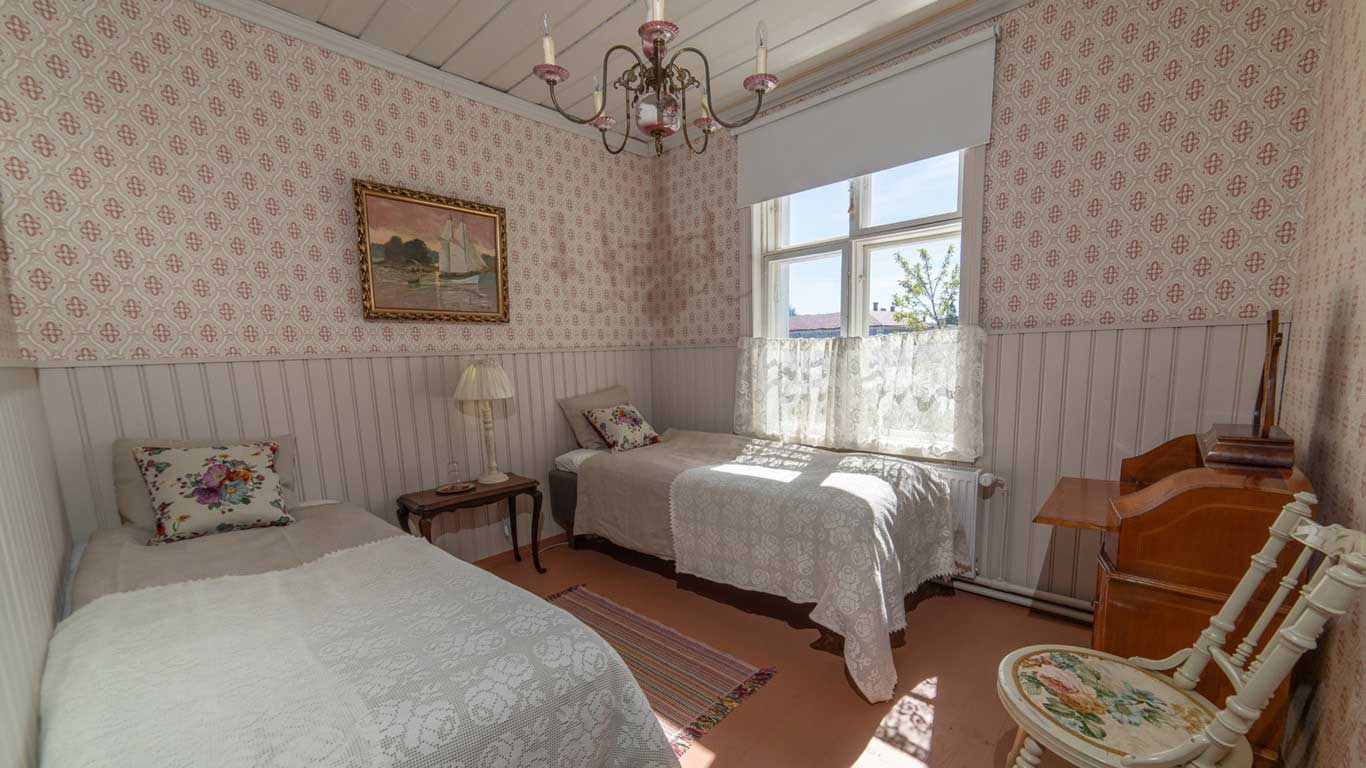
Shop Maiden’s Room
Lace and fragile dreams. High-quality accommodation for special moments in life.
Anna is an 18-year-old sea captain’s daughter. She is from an educated home and she has been taught to count and read at home. This is thanks to her father’s pride – he is pleased to tell people that at his house both boys and girls have these important basic skills, which are necessary in work life.
Anna lives in the Lower Mansion in the Shop Maiden’s Room, with a window towards the Big Market Square, right next to the shop which is in the corner. There is a benefit to being close to her workplace, also as she can keep an eye on the shop for burglars and all kinds of people, who come knocking on the shop door. It is also most important that she is there to open the door to farmers coming from afar if they come very early in the morning or late at night and show them a place to sleep in. There was no use in waking the master up or keep him up late with such matters.
They are living in the year 1860. The Lang House is run by Fredrik Sovelius Junior. He married Zachris Franzén’s daughter Johanna Margareta, known as Jenny, and after the old merchant died, Fredrik got the whole trade house to run in 1852.
Anna has decorated her room in a simple manner, but beautifully. On the wall, she has a painting of her childhood home in Kalajoki, and at her writing desk, she writes to her mother a letter every week and sends part of her salary to her family back home.

Accommodation in Raahe: Lang's magic at Pekkatori
We offer accommodation in the centre of Raahe, right in the heart of Old Raahe, in Pekkatori. Each hotel room tells the story of a historical person who lived in Lang's Manor and the interior design is timed to a specific stage in the person's life. You can visit in different periods of style, as the room decor is from different decades of the 19th century.
All rooms have their own toilet/bathroom. The hotel day starts at 15:00 and ends the next day at 12:00. The price includes breakfast, which is prepared from scratch in our own kitchen, just like in the house. Breakfast is served on weekdays from 7:00 to 9:30 and on Sundays from 8:00 to 10:30.
Earlier if requested in advance.
Our café-restaurant also serves lunch on weekdays. Some of the rooms are located in connection with Langin Kauppahuone and some in the adjacent Langin main building. Both buildings are of cultural and historical value and have been renovated with respect for the old building between 2016 and 2019. The buildings are protected and the old windows, doors and antique furniture are part of the story of the house.
Welcome to a journey through time!




